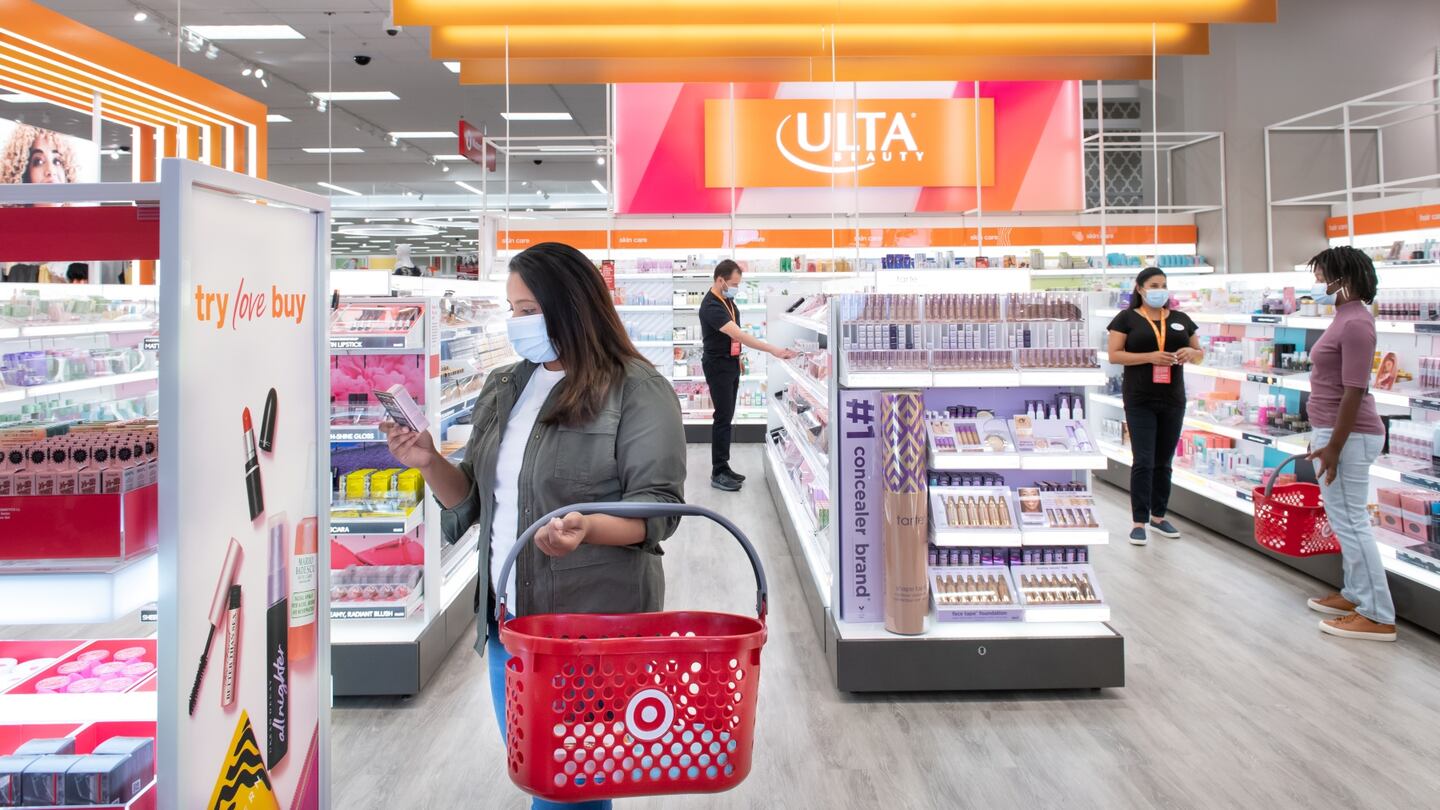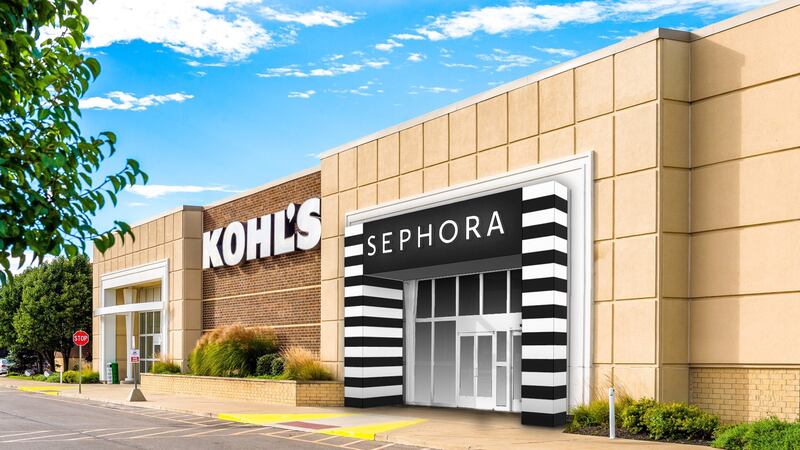
The Business of Fashion
Agenda-setting intelligence, analysis and advice for the global fashion community.

Agenda-setting intelligence, analysis and advice for the global fashion community.

When Lisa, a New Jersey mom, walked into the Ramsey, N.J. Kohl’s store on Aug. 17, it was to process an Amazon return. But she quickly made a detour after noticing her local Kohl’s was now carrying high-end beauty products, thanks to the arrival of the new Sephora location inside the store, which opened that week.
Browsing the Sephora boutique, she smelled a Drunk Elephant moisturiser, spritzed Tom Ford Ombré Leather perfume and sampled Makeup by Mario foundation before ultimately purchasing a Huda Beauty eyeliner and heading off to complete her Amazon return.
Lisa’s pit stop is precisely the sort of interaction both Kohl’s and Sephora hoped for when the two inked their shop-in-shop deal, which was announced last December and rolls out this month with the opening of 70 Sephora boutiques. Kohl’s plans to open 850 Sephora locations by 2023.
“We’ve historically had a small beauty business and we now feel we’ll be able to leapfrog and deliver on [beauty] by partnering with the global leader of prestige beauty,” Kohl’s chief marketing officer Doug Howe told BoF. “Sephora’s customer is younger, they are more diverse. The cross-shop opportunity is significant.”
ADVERTISEMENT
Kohl’s is just one of several big-box retailers investing in beauty. Target’s partnership with Sephora competitor Ulta also begins this month with the opening of around 100 Ulta shop-in-shops, with plans to eventually open Ulta boutiques in 800 Target locations. After shuttering its own 650 in-store Sephora boutiques following a legal spat that was settled last year, J.C. Penney is opening a newly revamped beauty department in October and plans to highlight brands from Black and brown founders.
Mass market retail’s bet on beauty — and beauty’s on mass market retail — represents a greater shift in how consumers want to buy their products and a blurring of the lines between mass and prestige. If done well, these partnerships offer endless opportunities for all involved to connect with new audiences and further tap a booming market.
“The old politics, where brands are carried in certain stores no longer applies because the consumer has evolved,” said Jenna Rosenstein, beauty director at Harper’s Bazaar. “They shop high and low, and they want to see trendy, even luxury beauty brands right alongside everything else.”
All Eyes on the Beauty Consumer
Beauty is a big business that’s only getting bigger — which is why big-box stores are taking an interest. Global beauty sales grew from $319 billion in 2009 to $500 billion in 2019, according to McKinsey. Though the pandemic saw a decline in makeup sales, it was a boom moment for other categories, such as skin care, creating momentum brands have continued to build on this year as they expand into new areas, like men’s skin care.
“Venture capitalists are seeing the opportunity in beauty, and in skin care in particular, because they are resilient to recessions,” said Sarah Broyd, beauty and personal care lead at Clarkston Consulting.
Retailers also see prestige beauty as a way to lure increasingly digitally-inclined consumers into stores. Despite e-commerce growth, many prefer to shop for beauty in stores in order to test, try and discover products. Piper Sandler’s annual survey teen survey found that 75 percent of Gen Z shoppers prefer to buy beauty in speciality format stores like Ulta and Sephora.
“Beauty is the last category that people will go lengths to see in person,” said Rosenstein. “They want to try, smell and swatch before purchasing. There’s an experience of walking around a beauty floor that’s fun and exciting.”
ADVERTISEMENT
Through partnerships with the likes of Ulta and Sephora, Kohl’s and Target can also capitalise on the reputation that the beauty retailers have already built. That was the primary reason that led Kohl’s to work with Sephora rather than building up its own beauty department. Kohl’s was also particularly interested in Sephora’s open-floor layout, said Howe, which offers a more modern experience from the classic department store beauty counter.
“Younger shoppers don’t always want to have to ask a human to help them, which is why high-end department stores haven’t bode well with the generational difference,” said Candace Corlett, president of WSL Strategic Retail.
In stores, beauty is getting prime placement. Kohl’s’ Sephora boutiques are located just near the store’s entrance and the partnership is advertised on the store’s front doors, to signal to shoppers that Kohl’s is now a beauty destination, said Howe. Adidas and Nike displays are located nearby, in an effort to appeal to young customers coming for beauty.
The prominent display of the Sephora partnership stands in contrast to Kohl’s’ team-up with Amazon. The retailer sells Amazon devices and processes Amazon returns, but displays no exterior Amazon signage and return bars are located deep inside stores.

A Mutually-Beneficial Relationship
Sephora and Ulta have their own reasons for getting into mass-market retail. Many Sephora locations, for example, are inside malls, which were experiencing waning foot traffic even before the pandemic. Kohl’s, by contrast, has a big off-mall retail presence, particularly in areas where access to luxury brands is limited, which will be “game-changing to a lot of local consumers,” said Rosenstein.
Target, Rosenstein added, has already developed a reputation for moving product in fashion and beauty, thanks to its deals with direct-to-consumer brands like Harry’s and Starface, as well as its designer clothing collaborations.
“Of course Ulta wants in on the ‘Target run,’” said Rosenstein.
ADVERTISEMENT
Bringing a speciality beauty retailer into a mass-market setting also will allow for brands to connect with consumers outside of their primary demographic. For Peace Out Skincare, which sells in 200 Sephora doors and has found success targeting Gen Z with acne products, gaining access to Kohl’s customers will enable the brand “to put emphasis on the anti-ageing category and focus on winning a more mature age consumer,” said JP McCary, the brand’s chief commercial officer.
Prestige brands also see Target and Kohl’s as a place to convert customers from other income brackets.
“We are not a box-off-the-shelf brand,” said Amy Errett, the founder and chief executive of hair colouring startup Madison Reed, which Ulta is bringing to Target. “We offer a superior choice so this gives us an opportunity to appeal to a customer from a prestige perspective.”
To boot, both Kohl’s and Target are handling the fulfilment and shipment of Sephora and Ulta orders placed on the beauty sections of their websites, easing the logistical burden for the beauty retailers.
The Keys to Succeed
Simply putting Sephora or Ulta products on shelves won’t be enough to entice consumers. Both Ulta and Sephora have trained retail employees at Target and Sephora respectively to support beauty shoppers inside stores, much as they inside standalone Ulta and Sephora locations.
“The store experience needs to feel like it’s personalised, like customers are getting served,” said Nadia Tuma-Weldon, head of the global luxury practice of advertising company McCann Worldgroup.
That includes making sure the product assortment appeals to a wide variety of consumers. Tuma-Weldon added that brands must prove they are dedicated to serving Black beauty consumers by carrying products for them, as well as showcasing Black beauty founders.
Target and Kohl’s are also allowing shoppers to earn points through their loyalty programmes as well at Sephora or Ulta, knowing that the store’s rewards programmes are a huge draw.
Staying on top of trends is also crucial. The Sephora Kohl’s store carries Jennifer Lopez and Selena Gomez’s beauty lines, while the Ulta Target sells Arianna Grande’s perfume. Kohl’s Sephora locations have walls displaying buzzy eyeliners, mascaras and skin care, while Target’s Ulta stores will have a “Trending Now” section.
“Succeeding in the beauty space comes down to newness,” said Rosenstein. “Shoppers want to be on top of the beauty zeitgeist, so stores need to keep highlighting the trends while staying on top of inventory and what products people are seeking out.”
Editor’s Note: This article was revised on 26 August 2021 to include the proper last name and title of Sarah Broyd.
Related Articles:
The Secret to Sephora’s Influencer Marketing Success
Sephora and Ulta Battle for the Big-Box Retail Market
How Digital Beauty Brands Are Making Wholesale Work
TikTok has birthed beauty trends with very little staying power. Despite this reality, labels are increasingly using sweet treats like glazed donuts, jelly and gummy bears to sell their products to Gen-Z shoppers.
This month, BoF Careers provides essential sector insights to help beauty professionals decode the industry’s creative landscape.
The skincare-to-smoothie pipeline arrives.
Puig and Space NK are cashing in on their ability to tap the growth of hot new products, while L’Occitane, Olaplex and The Estée Lauder Companies are discovering how quickly the shine can come off even the biggest brands.